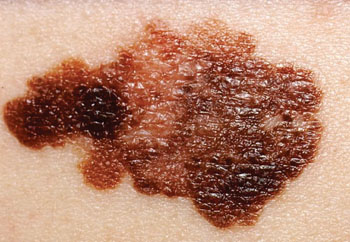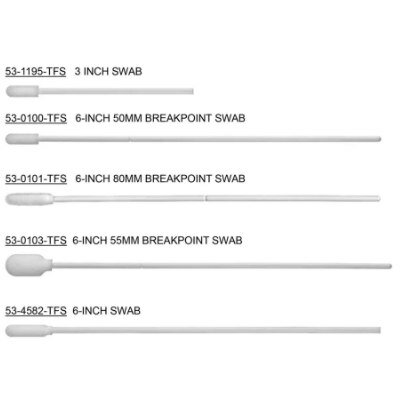Gene Test Predicts Melanoma Metastases
|
By LabMedica International staff writers Posted on 07 Apr 2014 |

Image: A melanoma on a patient\'s skin (Photo courtesy of the US National Cancer Institute).
A gene expression profile (GEP) test can identify primary cutaneous melanoma tumors that are likely to metastasize in patients who had a negative sentinel lymph node biopsy.
The noninvasive 31-gene GEP test that is widely used to determine metastatic risk in Stage I and II melanoma patients has been compared to sentinel lymph node biopsy (SLNB) which has traditionally been the best prognostic test available for melanoma patients.
Scientists at Castle Biosciences Inc. (Friendswood, TX, USA) compared their test called DecisionDx-Melanoma to results from134 patients with Stage I, II, or III cutaneous melanoma. These 134 patients represented all patients in the initial clinical validation studies who had a documented sentinel lymph node procedure. The DecisionDx-Melanoma is a proprietary test carried out in the company’s laboratories.
In patients with a negative SLNB, a result interpreted as a lower risk for metastasis, the GEP test identified the vast majority of melanomas that ultimately progressed over the subsequent five year period. The rate of five year metastasis-free survival (MFS) was 55% for SLNB negative patients compared to 37% for SLNB positive patients The GEP test results showed improved prognostic accuracy in these same patients with an MFS of 87% for the low-risk (Class 1) patients and 31% for the high risk (Class 2) patients.
The GEP test showed improved prognostic accuracy, with an overall survival (OS) for GEP Class 1 patients of 92% compared to 49% for Class 2 patients. The GEP test was also analyzed in combination with SLNB status. The 20% of patients who had high risk results for both tests (GEP Class 2 and SLNB positive) had lower survival rates (MFS=34%; OS=53%). Similarly, the 31% of patients who had low risk results for both tests (GEP Class 1 and SLNB negative) had higher survival rates (MFS=82%; OS=92%). Importantly, in the 49% of patients who had results that were discordant, high risk outcome for one test, low risk for the other, the GEP test result correctly predicted the patients' clinical outcomes. Net reclassification improvement of GEP class over SLNB status was greater than 50%.
Pedram Gerami, MD, the study author and an associate professor of Dermatology at Northwestern University (Evanston, IL, USA), said, “The results from this study show the GEP test is an independent predictor of metastasis and death, and significantly improves upon sentinel lymph node biopsy for staging melanoma patients. Based upon this data, optimal use of the GEP test may be to identify high risk patients among those with a negative SLNB result, or for patients who are ineligible for or who decline a SLNB procedure.” The study was presented at the 72nd Annual Meeting of the American Academy of Dermatology held March 21-25 2104 in Denver, CO, USA).
Castle Biosciences Inc.
Northwestern University
Related Links:
The noninvasive 31-gene GEP test that is widely used to determine metastatic risk in Stage I and II melanoma patients has been compared to sentinel lymph node biopsy (SLNB) which has traditionally been the best prognostic test available for melanoma patients.
Scientists at Castle Biosciences Inc. (Friendswood, TX, USA) compared their test called DecisionDx-Melanoma to results from134 patients with Stage I, II, or III cutaneous melanoma. These 134 patients represented all patients in the initial clinical validation studies who had a documented sentinel lymph node procedure. The DecisionDx-Melanoma is a proprietary test carried out in the company’s laboratories.
In patients with a negative SLNB, a result interpreted as a lower risk for metastasis, the GEP test identified the vast majority of melanomas that ultimately progressed over the subsequent five year period. The rate of five year metastasis-free survival (MFS) was 55% for SLNB negative patients compared to 37% for SLNB positive patients The GEP test results showed improved prognostic accuracy in these same patients with an MFS of 87% for the low-risk (Class 1) patients and 31% for the high risk (Class 2) patients.
The GEP test showed improved prognostic accuracy, with an overall survival (OS) for GEP Class 1 patients of 92% compared to 49% for Class 2 patients. The GEP test was also analyzed in combination with SLNB status. The 20% of patients who had high risk results for both tests (GEP Class 2 and SLNB positive) had lower survival rates (MFS=34%; OS=53%). Similarly, the 31% of patients who had low risk results for both tests (GEP Class 1 and SLNB negative) had higher survival rates (MFS=82%; OS=92%). Importantly, in the 49% of patients who had results that were discordant, high risk outcome for one test, low risk for the other, the GEP test result correctly predicted the patients' clinical outcomes. Net reclassification improvement of GEP class over SLNB status was greater than 50%.
Pedram Gerami, MD, the study author and an associate professor of Dermatology at Northwestern University (Evanston, IL, USA), said, “The results from this study show the GEP test is an independent predictor of metastasis and death, and significantly improves upon sentinel lymph node biopsy for staging melanoma patients. Based upon this data, optimal use of the GEP test may be to identify high risk patients among those with a negative SLNB result, or for patients who are ineligible for or who decline a SLNB procedure.” The study was presented at the 72nd Annual Meeting of the American Academy of Dermatology held March 21-25 2104 in Denver, CO, USA).
Castle Biosciences Inc.
Northwestern University
Related Links:
Latest Molecular Diagnostics News
- Blood Test Enables Non-Invasive Endometriosis Detection
- New Blood Biomarkers Help Diagnose Pregnancy-Linked Liver Complication
- Simple Urine Test to Revolutionize Bladder Cancer Diagnosis and Treatment
- Blood Test to Enable Earlier and Simpler Detection of Liver Fibrosis
- Genetic Marker to Help Children with T-Cell Leukemia Avoid Unnecessary Chemotherapy
- Four-Gene Blood Test Rules Out Bacterial Lung Infection
- New PCR Test Improves Diagnostic Accuracy of Bacterial Vaginosis and Candida Vaginitis
- New Serum Marker-Editing Strategy to Improve Diagnosis of Neurological Diseases
- World’s First Genetic Type 1 Diabetes Risk Test Enables Early Detection
- Blood Test to Help Low-Risk Gastric Cancer Patients Avoid Unnecessary Surgery
- First-Of-Its-Kind Automated System Speeds Myeloma Diagnosis
- Blood Protein Profiles Predict Mortality Risk for Earlier Medical Intervention
- First Of Its Kind Blood Test Detects Gastric Cancer in Asymptomatic Patients
- Portable Molecular Test Detects STIs at POC in 15 Minutes
- Benchtop Analyzer Runs Chemistries, Immunoassays and Hematology in Single Device
- POC Bordetella Test Delivers PCR-Accurate Results in 15 Minutes
Channels
Clinical Chemistry
view channel
Chemical Imaging Probe Could Track and Treat Prostate Cancer
Prostate cancer remains a leading cause of illness and death among men, with many patients eventually developing resistance to standard hormone-blocking therapies. These drugs often lose effectiveness... Read more
Mismatch Between Two Common Kidney Function Tests Indicates Serious Health Problems
Creatinine has long been the standard for measuring kidney filtration, while cystatin C — a protein produced by all human cells — has been recommended as a complementary marker because it is influenced... Read moreHematology
view channel
MRD Tests Could Predict Survival in Leukemia Patients
Acute myeloid leukemia is an aggressive blood cancer that disrupts normal blood cell production and often relapses even after intensive treatment. Clinicians currently lack early, reliable markers to predict... Read more
Platelet Activity Blood Test in Middle Age Could Identify Early Alzheimer’s Risk
Early detection of Alzheimer’s disease remains one of the biggest unmet needs in neurology, particularly because the biological changes underlying the disorder begin decades before memory symptoms appear.... Read more
Microvesicles Measurement Could Detect Vascular Injury in Sickle Cell Disease Patients
Assessing disease severity in sickle cell disease (SCD) remains challenging, especially when trying to predict hemolysis, vascular injury, and risk of complications such as vaso-occlusive crises.... Read more
ADLM’s New Coagulation Testing Guidance to Improve Care for Patients on Blood Thinners
Direct oral anticoagulants (DOACs) are one of the most common types of blood thinners. Patients take them to prevent a host of complications that could arise from blood clotting, including stroke, deep... Read moreImmunology
view channel
Routine Blood Test Can Predict Who Benefits Most from CAR T-Cell Therapy
CAR T-cell therapy has transformed treatment for patients with relapsed or treatment-resistant non-Hodgkin lymphoma, but many patients eventually relapse despite an initial response. Clinicians currently... Read more
New Test Distinguishes Vaccine-Induced False Positives from Active HIV Infection
Since HIV was identified in 1983, more than 91 million people have contracted the virus, and over 44 million have died from related causes. Today, nearly 40 million individuals worldwide live with HIV-1,... Read more
Gene Signature Test Predicts Response to Key Breast Cancer Treatment
DK4/6 inhibitors paired with hormone therapy have become a cornerstone treatment for advanced HR+/HER2– breast cancer, slowing tumor growth by blocking key proteins that drive cell division.... Read more
Chip Captures Cancer Cells from Blood to Help Select Right Breast Cancer Treatment
Ductal carcinoma in situ (DCIS) accounts for about a quarter of all breast cancer cases and generally carries a good prognosis. This non-invasive form of the disease may or may not become life-threatening.... Read moreMicrobiology
view channel
Blood-Based Diagnostic Method Could Identify Pediatric LRTIs
Lower-respiratory tract infections (LRTIs) are a leading cause of illness and death worldwide, and pneumonia is the leading infectious cause of death in children under five, claiming the lives of over... Read more
Rapid Diagnostic Test Matches Gold Standard for Sepsis Detection
Sepsis kills 11 million people worldwide every year and generates massive healthcare costs. In the USA and Europe alone, sepsis accounts for USD 100 billion in annual hospitalization expenses.... Read moreRapid POC Tuberculosis Test Provides Results Within 15 Minutes
Tuberculosis remains one of the world’s deadliest infectious diseases, and reducing new cases depends on identifying individuals with latent infection before it progresses. Current diagnostic tools often... Read more
Rapid Assay Identifies Bloodstream Infection Pathogens Directly from Patient Samples
Bloodstream infections in sepsis progress quickly and demand rapid, precise diagnosis. Current blood-culture methods often take one to five days to identify the pathogen, leaving clinicians to treat blindly... Read morePathology
view channel
Rapid Low-Cost Tests Can Prevent Child Deaths from Contaminated Medicinal Syrups
Medicinal syrups contaminated with toxic chemicals have caused the deaths of hundreds of children worldwide, exposing a critical gap in how these products are tested before reaching patients.... Read more
Tumor Signals in Saliva and Blood Enable Non-Invasive Monitoring of Head and Neck Cancer
Head and neck cancers are among the most aggressive malignancies worldwide, with nearly 900,000 new cases diagnosed each year. Monitoring these cancers for recurrence or relapse typically relies on tissue... Read more
Common Health Issues Can Influence New Blood Tests for Alzheimer’s Disease
Blood-based tests for Alzheimer’s disease are transforming diagnosis by offering a simpler alternative to spinal taps and brain imaging. However, many people evaluated at memory clinics also live with... Read more
Blood Test Formula Identifies Chronic Liver Disease Patients with Higher Cancer Risk
Chronic liver disease affects millions worldwide and can progress silently to hepatocellular carcinoma (HCC), one of the deadliest cancers globally. While surveillance guidelines exist for patients with... Read moreTechnology
view channel
Artificial Intelligence Model Could Accelerate Rare Disease Diagnosis
Identifying which genetic variants actually cause disease remains one of the biggest challenges in genomic medicine. Each person carries tens of thousands of DNA changes, yet only a few meaningfully alter... Read more
AI Saliva Sensor Enables Early Detection of Head and Neck Cancer
Early detection of head and neck cancer remains difficult because the disease produces few or no symptoms in its earliest stages, and lesions often lie deep within the head or neck, where biopsy or endoscopy... Read moreIndustry
view channel
Abbott Acquires Cancer-Screening Company Exact Sciences
Abbott (Abbott Park, IL, USA) has entered into a definitive agreement to acquire Exact Sciences (Madison, WI, USA), enabling it to enter and lead in fast-growing cancer diagnostics segments.... Read more

















